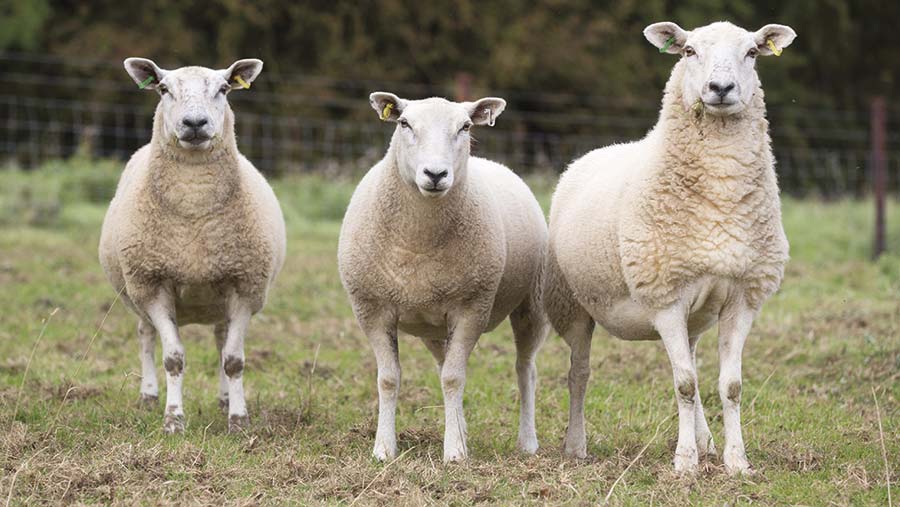Outlook 2018: Strength of sterling key to lamb prices

If recently improved lamb prices are to be maintained in the run-up to Brexit, sterling will need to stay weak to underpin export volumes, while supplies from New Zealand will need to remain at reduced levels.
The weak pound has helped exports rise 13% for the first nine months of 2017 compared with the same period in 2016.
Coinciding with this, historically low production in New Zealand could see exports to the UK fall by over 20% in 2017 compared with the previous year, says Andersons director David Siddle.
See also: Trading with China: Opportunities for livestock producers
Summary
- Strength of sterling and levels of NZ imports are key factors governing shorter-term lamb prices
- Similar number of lambs to 2017 likely to be carried over into the new year; bigger breeding flock looks likely
- Longer-term outlook is for smaller but more productive UK flock with lower net costs of production
“While a significant strengthening of sterling seems unlikely at least in the short term, low levels of New Zealand imports may not last indefinitely.
“The major global exporters of sheep meat, New Zealand and Australia, have both seen their flocks hit by drought and are now rebuilding.
“This has come at a time when world markets have been generally stronger and demand from China, now the world’s largest importer of sheep meat, is increasing.”
Increase in production
Once flock numbers have been rebuilt, this will lead to an increase in production and export availability. This is likely to have an impact on the UK sheep meat market at some point.
More immediately, the fall in sterling and reduced NZ imports appears fortunate timing as the UK breeding flock has increased from 13.8 million ewes in 2010 to 14.8 million ewes today, says Mr Siddle.
The early part of 2017 was overshadowed by poor prices for hoggets due to a large carryover from 2016. However, as increasing numbers of new-season lambs came on stream, coinciding with the beginning of the main UK export period, prices during the summer were well above the previous year.
“We could be looking at a similar carryover of lambs into 2018 as last year. Fortunately, as last spring, there won’t be huge amount of NZ supply to compete, which indicates similar price prospects for the first quarter of 2018,” he adds.
Judging by the early breeding sheep sales, producers’ confidence has been boosted by this season’s better prices, says Mr Siddle.
“Despite the profitability challenges faced by many producers and the well-trailed risks posed to the sheep sector by Brexit, another increase in the breeding flock looks likely going into 2018.”
Smaller flocks
Further ahead, he forecasts a smaller but more productive UK flock, given the mature market for sheep meat, both in the UK and the EU, and difficulty of breaking into China, the only real growing market for sheep meat in the world.
“Australian and New Zealand producers are more competitive, and the demand in China tends to be for lower quality cuts, rather than the high-quality carcasses and cuts that UK exports have been built upon.”
This smaller flock will be managed by fewer producers able to make sustainable profits with much lower or no support payments. Improved competitiveness and lower costs of production will be key, says Mr Siddle.
“To achieve positive net margins, flocks generally need to achieve a net output, after replacement costs, above £95/ewe. This will exclude most flocks incapable of producing lambing percentages in excess of 135%.”
Systems need to make maximum use of forage, in particular grazed grass, with purchased feed typically below £10/ewe, he advises.
Flocks selecting for easy-care traits, such as ease of lambing, good feet, lack of daggs, worm resistance and good mothering ability, tend to have not only lower veterinary and medicine costs but also, critically, lower fixed costs, essential to produce positive net margins,
Intensive winter-housed systems targeting very high lambing percentages are increasingly struggling to cover the higher labour, machinery and conserved winter forage costs they incur, says Mr Siddle.
“We expect a continued move to forage-based outdoor systems, with perhaps more modest lambing percentages, but lower net costs of production.”
Farmers Weekly says…
Michael Priestley, livestock reporter
- A weaker sterling ensured decent prime lamb prices (211-246p/kg liveweight) in 2017, particularly through mid-summer, although uncertainty now looms.
- The fate of about one-third of UK sheep meat production teeters on Brexit trade talks and with it so does the livestock auctioneering industry as we currently know it.
- On the management side, sheep farms must half the amount of high priority antibiotics they use and reduce overall usage by 10% by 2020. This will mean more vaccinations (enzootic abortion, footrot) and moving to outdoor lambing systems, which many are adopting as a cost-cutting measure ahead of direct subsidy cuts.
Andersons outlook
The above is based on Andersons Outlook 2018. Copies of the full publication can be downloaded from www.andersons.co.uk by clicking on ‘Publications and Events’ or by requesting a printed copy on 01664 503200.
Andersons is running a series of seminars in the spring, looking at the prospects for UK agriculture in greater detail. For more information, please go to www.theandersonscentre.co.uk/seminars.
2 March – RAF Club, Piccadilly, London
6 March – Harper Adams University, Newport, Shropshire
7 March – Castle Green Hotel, Kendal, Cumbria
8 March – Carfraemill Lodge Hotel, Lauder, Berwickshire
9 March – York Racecourse, York, North Yorkshire
13 March – Yew Lodge Hotel, Kegworth Leicestershire
14 March – Perth Racecourse, Perth
16 March – Newmarket Racecourse (Rowley Mile), Newmarket, Suffolk
20 March – Royal Agricultural University, Cirencester, Gloucestershire
21 March – Exeter Racecourse, Exeter, Devon
22 March – Salisbury Racecourse, Salisbury, Wiltshire
23 March – East of England Showground, Peterborough, Cambridgeshire
